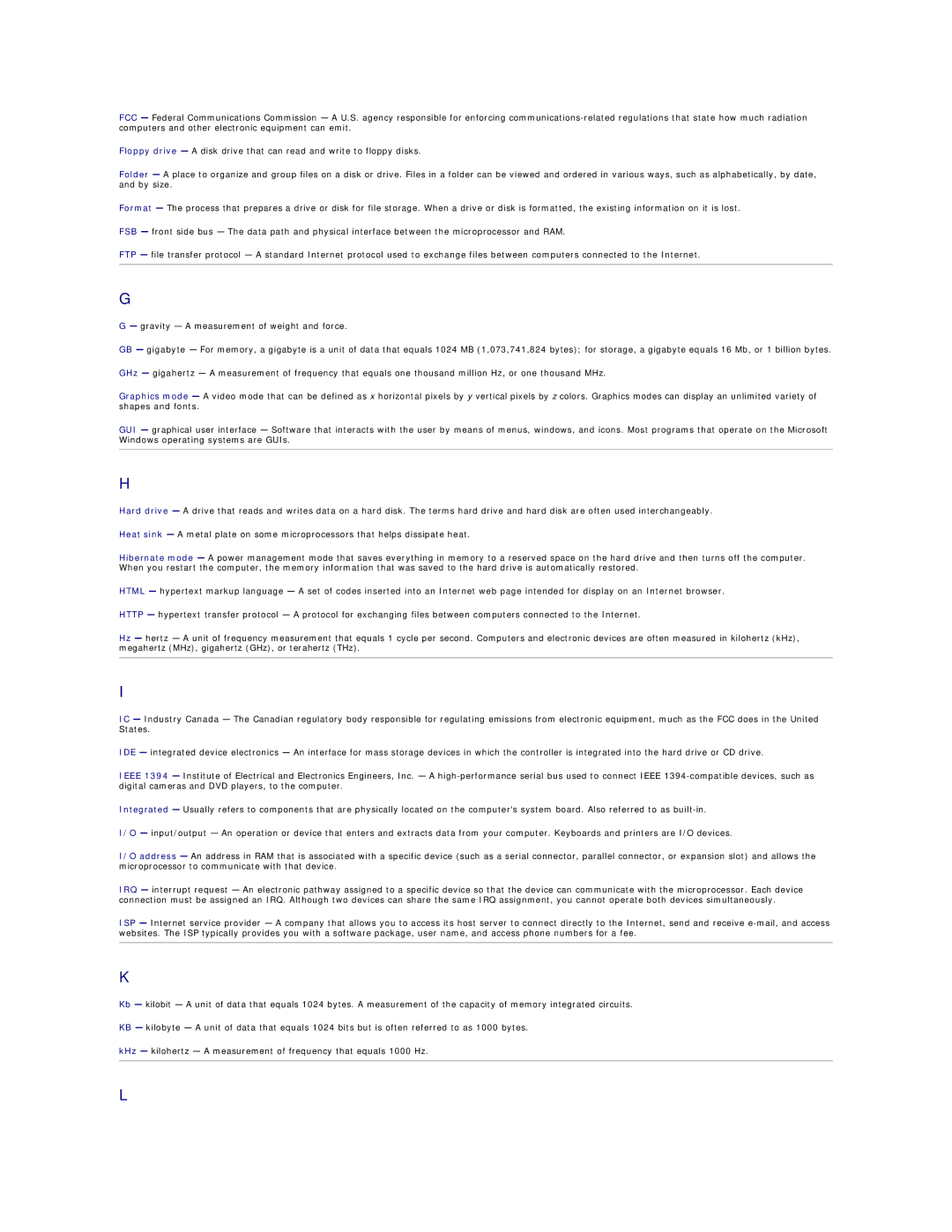
FCC — Federal Communications Commission — A U.S. agency responsible for enforcing
Floppy drive — A disk drive that can read and write to floppy disks.
Folder — A place to organize and group files on a disk or drive. Files in a folder can be viewed and ordered in various ways, such as alphabetically, by date, and by size.
Format — The process that prepares a drive or disk for file storage. When a drive or disk is formatted, the existing information on it is lost.
FSB — front side bus — The data path and physical interface between the microprocessor and RAM.
FTP — file transfer protocol — A standard Internet protocol used to exchange files between computers connected to the Internet.
G
G — gravity — A measurement of weight and force.
GB — gigabyte — For memory, a gigabyte is a unit of data that equals 1024 MB (1,073,741,824 bytes); for storage, a gigabyte equals 16 Mb, or 1 billion bytes.
GHz — gigahertz — A measurement of frequency that equals one thousand million Hz, or one thousand MHz.
Graphics mode — A video mode that can be defined as x horizontal pixels by y vertical pixels by z colors. Graphics modes can display an unlimited variety of shapes and fonts.
GUI — graphical user interface — Software that interacts with the user by means of menus, windows, and icons. Most programs that operate on the Microsoft Windows operating systems are GUIs.
H
Hard drive — A drive that reads and writes data on a hard disk. The terms hard drive and hard disk are often used interchangeably.
Heat sink — A metal plate on some microprocessors that helps dissipate heat.
Hibernate mode — A power management mode that saves everything in memory to a reserved space on the hard drive and then turns off the computer. When you restart the computer, the memory information that was saved to the hard drive is automatically restored.
HTML — hypertext markup language — A set of codes inserted into an Internet web page intended for display on an Internet browser.
HTTP — hypertext transfer protocol — A protocol for exchanging files between computers connected to the Internet.
Hz — hertz — A unit of frequency measurement that equals 1 cycle per second. Computers and electronic devices are often measured in kilohertz (kHz), megahertz (MHz), gigahertz (GHz), or terahertz (THz).
I
IC — Industry Canada — The Canadian regulatory body responsible for regulating emissions from electronic equipment, much as the FCC does in the United States.
IDE — integrated device electronics — An interface for mass storage devices in which the controller is integrated into the hard drive or CD drive.
IEEE 1394 — Institute of Electrical and Electronics Engineers, Inc. — A
Integrated — Usually refers to components that are physically located on the computer's system board. Also referred to as
I/O — input/output — An operation or device that enters and extracts data from your computer. Keyboards and printers are I/O devices.
I/O address — An address in RAM that is associated with a specific device (such as a serial connector, parallel connector, or expansion slot) and allows the microprocessor to communicate with that device.
IRQ — interrupt request — An electronic pathway assigned to a specific device so that the device can communicate with the microprocessor. Each device connection must be assigned an IRQ. Although two devices can share the same IRQ assignment, you cannot operate both devices simultaneously.
ISP — Internet service provider — A company that allows you to access its host server to connect directly to the Internet, send and receive
K
Kb — kilobit — A unit of data that equals 1024 bytes. A measurement of the capacity of memory integrated circuits.
KB — kilobyte — A unit of data that equals 1024 bits but is often referred to as 1000 bytes.
kHz — kilohertz — A measurement of frequency that equals 1000 Hz.
L
